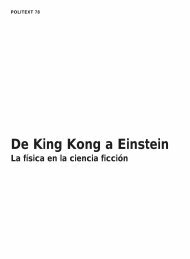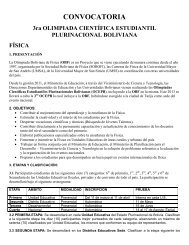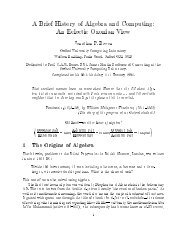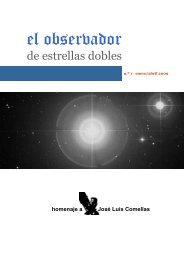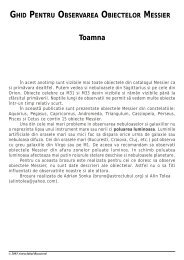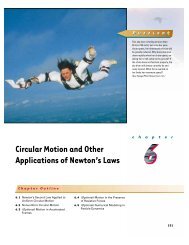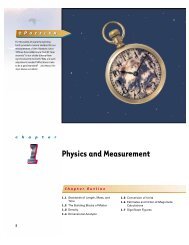You also want an ePaper? Increase the reach of your titles
YUMPU automatically turns print PDFs into web optimized ePapers that Google loves.
gions where the gas is compressed and thus the density and pressure are above<br />
their equilibrium values. A compressed region is formed whenever the piston is<br />
pushed into the tube. This compressed region, called a condensation, moves<br />
through the tube as a pulse, continuously compressing the region just in front<br />
<strong>of</strong> itself. When the piston is pulled back, the gas in front <strong>of</strong> it expands, and the<br />
pressure and density in this region fall below their equilibrium values (represented<br />
by the lighter parts <strong>of</strong> the colored areas in Fig. 17.2). These low-pressure<br />
regions, called rarefactions, also propagate along the tube, following the condensations.<br />
Both regions move with a speed equal to the speed <strong>of</strong> sound in the<br />
medium.<br />
As the piston oscillates sinusoidally, regions <strong>of</strong> condensation and rarefaction<br />
are continuously set up. The distance between two successive condensations (or<br />
two successive rarefactions) equals the wavelength �. As these regions travel<br />
through the tube, any small volume <strong>of</strong> the medium moves with simple harmonic<br />
motion parallel to the direction <strong>of</strong> the wave. If s(x, t) is the displacement <strong>of</strong> a small<br />
volume element from its equilibrium position, we can express this harmonic displacement<br />
function as<br />
s(x, t) � s max cos(kx � �t)<br />
(17.2)<br />
where smax is the maximum displacement <strong>of</strong> the medium from equilibrium<br />
(in other words, the displacement amplitude <strong>of</strong> the wave), k is the angular<br />
wavenumber, and � is the angular frequency <strong>of</strong> the piston. Note that the displacement<br />
<strong>of</strong> the medium is along x, in the direction <strong>of</strong> motion <strong>of</strong> the sound wave,<br />
which means we are describing a longitudinal wave.<br />
As we shall demonstrate shortly, the variation in the gas pressure �P, measured<br />
from the equilibrium value, is also periodic and for the displacement function<br />
in Equation 17.2 is given by<br />
�P ��P max sin(kx � �t)<br />
17.2 <strong>Periodic</strong> <strong>Sound</strong> <strong>Waves</strong> 523<br />
(17.3)<br />
where the pressure amplitude �P max—which is the maximum change in pres-<br />
λ<br />
P<br />
Figure 17.2 A sinusoidal longitudinal wave propagating<br />
through a gas-filled tube. The source <strong>of</strong> the wave is a sinusoidally<br />
oscillating piston at the left. The high-pressure and<br />
low-pressure regions are colored darkly and lightly, respectively.<br />
TABLE 17.1<br />
Speeds <strong>of</strong> <strong>Sound</strong> in Various<br />
Media<br />
Medium v (m/s)<br />
Gases<br />
Hydrogen (0°C) 1 286<br />
Helium (0°C) 972<br />
Air (20°C) 343<br />
Air (0°C) 331<br />
Oxygen (0°C) 317<br />
Liquids at 25°C<br />
Glycerol 1 904<br />
Sea water 1 533<br />
Water 1 493<br />
Mercury 1 450<br />
Kerosene 1 324<br />
Methyl alcohol 1 143<br />
Carbon tetrachloride 926<br />
Solids<br />
Diamond 12 000<br />
Pyrex glass 5 640<br />
Iron 5 130<br />
Aluminum 5 100<br />
Brass 4 700<br />
Copper 3 560<br />
Gold 3 240<br />
Lucite 2 680<br />
Lead 1 322<br />
Rubber 1 600



